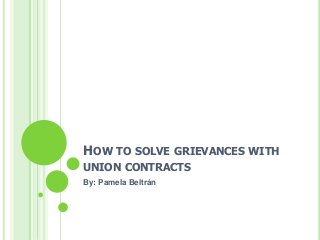
How to solve grievances with union contracts
- 1. HOW TO SOLVE GRIEVANCES WITH UNION CONTRACTS By: Pamela Beltrán
- 2. WHAT ARE UNIONS? Unions are organizations that negotiate with corporations, businesses and other organizations on behalf of union members. There are trade unions, which represent workers who do a particular type of job, and industrial unions, which represent workers in a particular industry.
- 3. WHAT DO UNIONS DO? Unions have often been credited with securing improvements in working conditions and wages. Many unions were formed in manufacturing and resource companies, companies operating in steel mills, textile factories and mines.
- 4. HOW DO UNIONS AFFECT LABOR ENVORNMENT? The power of labor unions rests in their two main tools of influence: restricting labor supply and increasing labor demand. Through collective bargaining, unions negotiate the wages that employers will pay. Unions ask for a higher wage than the equilibrium wage (found at the intersect of the labor supply and labor demand curves), but this can lower the hours demanded by employers. Unions have a unique legal position and in some sense, they operate like a monopoly as they are immune to antitrust laws. Because unions control, or can exert a good deal of influence on, the labor supply for a particular company or industry, unions can restrict non-union workers from depressing the wage rate. They are able to do this because legal guidelines provide a certain level of protection to union activities.
- 5. WHAT CAN UNIONS DO DURING NEGOTIATIONS? When unions want to increase union member wages or request other concessions from employers, they can do so through collective bargaining. Collective bargaining is a process in which workers (through a union) and employers meet to discuss the employment environment. Unions will present their argument for a particular issue, and employers must decide whether to concede to the workers' demands or to present counterarguments. If unions are unable to negotiate, or are not satisfied with the outcomes of collective bargaining, they may initiate a work stoppage or strike.
- 6. WHAT GOES IN A UNION CONTRACT? There are no typical union contracts, because every workplace is slightly different, and so are working conditions. However, some basic things are the same. All contracts are products of negotiations between the workers and the boss. They are usually written in boring, legal terms, but these are very important for securing your rights in the workplace.
- 7. A TYPICAL GRIEVANCE PORCESS In a union environment, a typical grievance procedure begins with an employee presenting a problem to his or her immediate supervisor within a certain time period after the offending event has occurred. The supervisor then has a set amount of time to either respond or send the grievance on to be addressed by the head of the department. At this point, a union representative enters the negotiations on behalf of the employee. If the situation is still not resolved, the grievance continues up the chain of command to the plant manager and the president of the local union. If the labor union fails to follow the procedures at any point, the contract usually specifies that it must drop the grievance. Conversely, the company is usually obligated to resolve the grievance in the employee's favor if management fails to follow the procedures outlined in the collective bargaining agreement. If the situation still cannot be resolved, the final step in the grievance process is for both parties to present their side to an arbitrator.
- 8. WHAT IS A UNION CONTRACT? A union contract - also called a "collective bargaining agreement" - is a legally binding document that is binding by law between the employee and the employer. It is negotiated with the employer and provides for, among other things, wages, benefits, hours, general working conditions, and procedures for addressing problems on the job. The advantages of having a Collective Agreement are many. Among the biggest is that everyone is subject to the same rules -- no favoritism, no wage disparity, not unjustified discipline.
